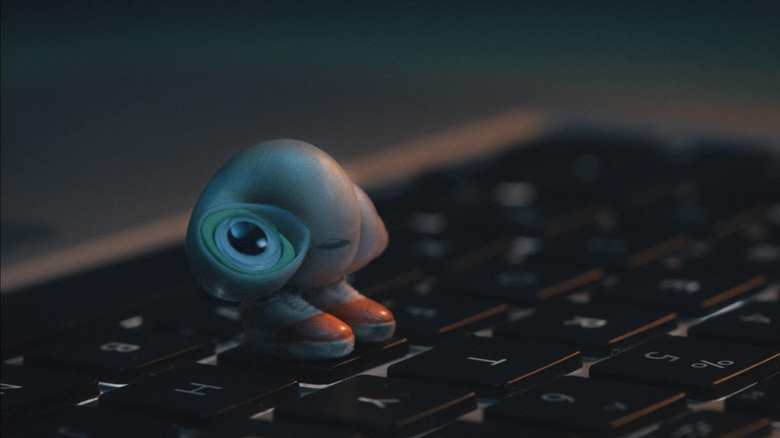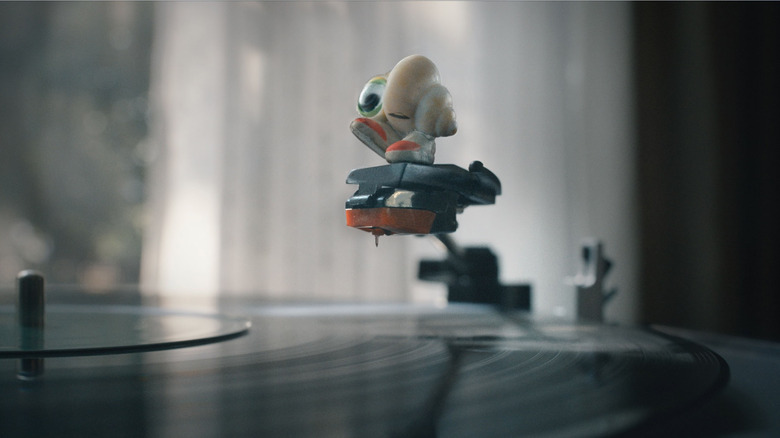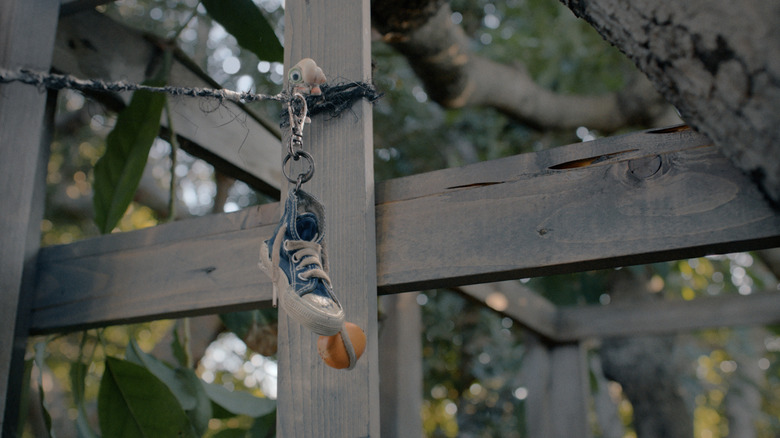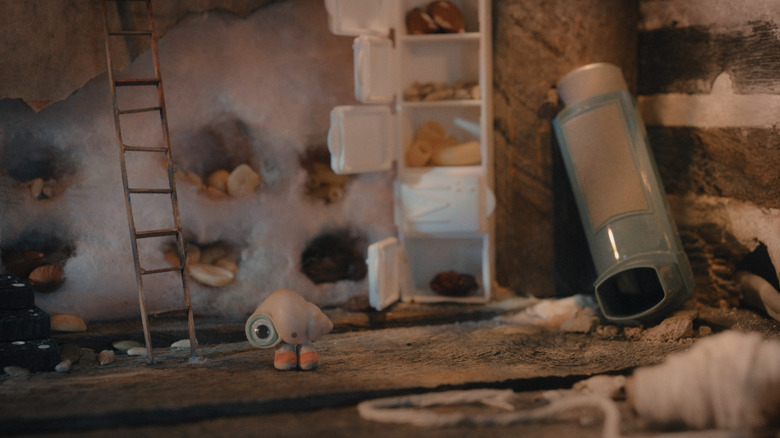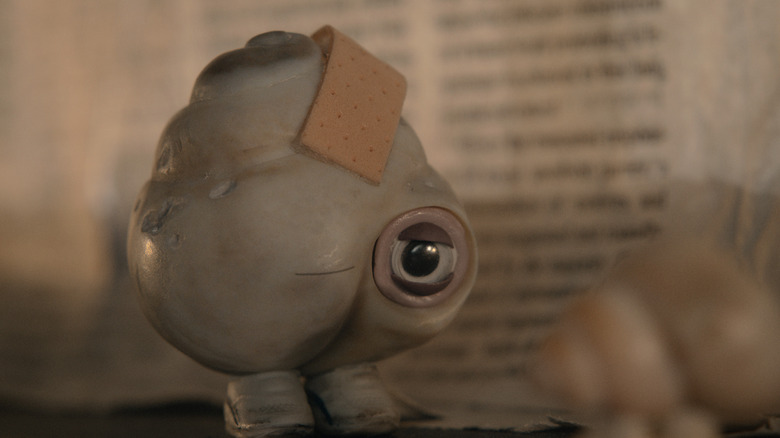Marcel The Shell With Shoes On Animation Director Kirsten Lepore Wants To Slow Things Down [Interview]
Kirsten Lepore has been celebrated for her work in stop-motion animation, such as the acclaimed "Adventure Time" episode "Bad Jubies" and her short films like "Sweet Dreams," "Bottle," and "Move Mountain." But it's probably rare for her to get the direction to animate something "less good."
But that's kind of what happened on the set of "Marcel the Shell With Shoes On," the wonderful, whimsical hybrid stop-motion/live-action film based on the viral shorts by Dean Fleischer-Camp. Fleischer-Camp returns to direct and star in "Marcel the Shell With Shoes On," turning his series of three-minute shorts into a full-fledged feature film with the help of Lepore, who serves as animation director. Lepore not only had the challenge of joining a tight-knit crew (which includes "Marcel" co-writers and co-creators Jenny Slate and Nick Paley), but she had to make the film loyal to the shorts' DIY stop-motion style. That meant "making it look less good," or rather, making sure the animation was just "less."
"[T]he initial tendency is to over-animate and have too much movement all the time," Lepore told me in an interview ahead of the release of "Marcel the Shell With Shoes On," in theaters now. "The character's constantly moving, but it's really counter to comedy. The way you really get great comedy and comedic timing is there needs to be a lot of pauses in there."
Just as much as this more slow-paced animation is necessary for the comedy in a movie about an adorable sentient shell, the style of animation is also necessary in a movie that will make you cry over an adorable sentient shell.
"[I]n the noise of crazy cartoon loud action, things constantly happening, I always think it's nice to slow down and take a breath," Lepore said.
I spoke with Lepore about the stop-motion animation process, how shape-shifting raccoons in a Studio Ghibli movie influenced "Marcel," and the most challenging part of working with one-inch puppets.
'The way you really get great comedy and comedic timing is there needs to be a lot of pauses in there'
You were brought on as animation director for the "Marcel the Shell With Shoes On" movie after the viral shorts had already established the distinct animation style for "Marcel." Was it a challenge adapting to that specific style?
I would say there were a few challenges with maybe matching the style of the lip sync because I know that was really, really particular with Dean [Fleischer-Camp]. It was all actually composite mouths on top. That was the only part that just wasn't in there in the original stop-motion footage. We did it without mouths and then the mouths were added later and then it was just very specific rough or jerkier performances for the mouths that took a little getting used to for me once we got to that stage in the process. But I would say with the actual animation, it was really fun. And actually a really great process of amping that up to the feature level, because what Dean did originally was very, very rudimentary stop-motion.
And he always knew from the beginning that once we brought this up to the feature level, he wanted to really up the production value and have the animation be a bit smoother and more traditionally stop-motion animated. So that was super fun to just bring it a little bit more into a real-life world look. We did a lot of testing on that. We had to, in testing, go too far and too smooth before we backed off and realized, "Okay, we actually need to shoot this still with a little bit of rough around the edges feel," which translated to the frame rate being a little bit jerkier. But I feel like it gave us a nice step up from the look of the shorts to the look of the feature.
So what was it like trying to achieve that balance? Because I spoke with Dean the other day about the difference between doing the stop-motion animation for his DIY shorts and then animating on that feature film scale, and he talked about how he would often direct animators to "make it look less good." Was this something that, as an animator, felt like it was going against your instincts?
I was really on the same page with him from the beginning about just how subtle the performance needed to be. And I know what he was getting at too with making it look less good. I think how I would translate that to the animators was doing less because animators — I mean, I'm an animator, I love animators for better or for worse — they want to show what they can do, and show their skills, and show off a little bit. So I feel like the initial tendency is to over-animate and have too much movement all the time. The character's constantly moving, but it's really counter to comedy. The way you really get great comedy and comedic timing is there needs to be a lot of pauses in there.
You need to really hold a funny pose or hold that character until the right moment to just put a perfectly placed blink in there or a perfectly placed other action. So that was a little bit of — and I knew it would be — it was a little bit of a learning curve for the animators in the beginning. But I think after a week or two, everyone really started to get into the hang of it after Jean and I were going in there incessantly and being like, "Less movement, less movement, just hold, all you have to do hold and blink." So this is pretty much what we kept instructing them to do. And then by the end, I think we came up with a nice balance and I'm happy where we landed.
'But at the end of the day, it was just the simple magic of compositing and matching lighting really well'
Can you describe to me the process by which you animated the stop-motion elements of the movie? Because it is a hybrid movie. It takes place partially in the real world with real people, but also it has all these little stop-motion elements that are just blended with the reality very seamlessly. So what was the process by which they came together?
So we basically had two different shoots. We shot the movie twice. So the first shoot was the live-action shoot where we got all of our plates and real world stuff. My job on that set was mostly to come in with a little Marcel puppet on a rod and just walk him through the scene so that everyone knew, "Okay, where are we even focusing the camera? And how fast is he going to move? What's his action going to be?" And I did my best to approximate, "Okay, once he's animated, I think he'll be able to move this far and do this thing." So we would run it through with the puppet once, [the assistant cameraperson] would figure out where that focus should be, and then we would take the puppet out and we would run it again with nothing in there, just the empty plate. And that's what we ended up using once we got to compositing.
So then on the other side, there was the stop-motion shoot. So that came a year after the live action shoot. Our DP basically had to match the lighting of the live action shoot perfectly. He was also there. He had taken crazy notes, overhead diagrams, putting out measuring tapes and everything to remember exactly what the lighting was for each shot on the live action stage. And then he translated that once we got on the stop-motion stage and most of the time on our stop-motion stage, we would just have a little portion of that set that we would recreate. So sometimes it was as simple as a little gray floating piece of wood on a C-stand, and Marcel was just in that immediate area.
Or sometimes we would go as big as rebuilding one of the live action sets, particularly the jewelry box set where Nana Connie is, that whole corner of the house, that little area that her jewelry box sits on. We rebuilt that whole thing in stop-motion. It just gave us a lot more flexibility, but even the production designers had to hand age that and craft that so it looked as real and believable as it did in the actual house on the live action set. So yeah, we did our animation there and then it was basically up to the VFX team to composite everything together. And that whole process, I wasn't super involved in, but that was many, many, many months of effect shots and rotoscoping and compositing. Yeah.
Another fun tidbit I just remembered is that we couldn't use green screen for anything, which also made the process more challenging because he is so tiny that if you put Marcel in a green card, you're just going to get nothing but green light reflecting off of the green card. He's just all spill. He's just all green spill. So that really made it more challenging where we had to use gray cards and just do rotoscoping instead. Yeah. Tons of technical challenges. But at the end of the day, it was just the simple magic of compositing and matching lighting really well.
So it sounds incredibly regimented, especially on the live-action side who have to shoot their parts and then hope for the best when everything is said and done. And speaking of Dean, he was the co-lead of sorts in this film and would often be the sole person interacting with these stop-motion creatures. Were there any challenges that he had to overcome as both director and also the person who was interacting with all of these characters that he wouldn't see until a year or two later?
Yeah, I think in terms of him acting in it, yeah. I think he did a really good job playing it pretty naturally. And most of the time it was just Marcel sitting next to him and sometimes we would just have a stand-in, which sometimes even just having a stand-in is like super helpful to play off of. So yeah, in terms of his action, it never seemed to be an issue on the live action stage. He was very natural. I feel like the integration between other things maybe were a little more challenging — the dog, for example. We had actual dog on set hopping up and it was just again, a lot of approximations of, "Okay, the dog comes up here, don't let the dog cross this point or else it's going to break our shot for stop-motion."
So just trying to be really meticulous and calculated about exactly where everything needed to go. And then on the stop-motion stages, just lining it up. We have software on the stop-mo stages where you can onion skin and see through to what the plate looks like. So you're already getting a sense, as you're animating, what the setting is and where he is. And things like the dog when, when the nose would come in, the stop-motion animator knew exactly where that was going to be on a frame by frame basis. So they could animate accordingly and adjust.
'I always think it's nice to slow down and take a breath'
Speaking of before what you were saying about the movement in this movie and trying to scale back that movement to give that more DIY feeling that the original shorts had there, it feels like it's against the grain of what everything is in modern Hollywood animation, which is about making it more about movement, more about realism. This scaling back of things reminds me a lot, actually of a Studio Ghibli film, except with a modern millennial update. Were Ghibli films used at all as references while animating Marcel?
We didn't have them on the stop-motion stages to look at, but Dean and I actually did talk a lot about Miyazaki films when we were first storyboarding. I think it really influenced our storyboard phase. I remember a vivid conversation that we had up in Dean's studio downtown, where we just kept showing each other our favorite Ghibli gifs or whatever. Dean had showed me the one of, there's this character that's almost like a flying squirrel, but it has huge balls...
Yes, "Pom Poko!"
[laughs] "Pom Poko," yeah. But it was so funny and we just, I don't know, we kept going back and forth and really just at the heart of that conversation was just admiring the restraint of that animation and of that type of storytelling.
And I think that's one of the reasons I was really attracted to working on this project is because the pacing really, really resonated with me. There's something just cozy about settling into Marcel's world that is reminiscent of settling into a beautiful Miyazaki scene that is just about appreciating the details and nature and the subtlety of everything around you. That's something that I really value personally. And I love that we were able to make a movie that also has that at its heart. Especially like you said, in the noise of crazy cartoon loud action, things constantly happening, I always think it's nice to slow down and take a breath. And that's what this movie feels like.
What do you think is the importance of having these steady, slow-paced animated movies for families as the counter programming to these very flashy, fast-paced, CG animated movies that are so the norm for Hollywood?
I hope it's a nice alternative for people. I hope it shows people that — it is a very unique movie, because not many animated films and animated family films do that. So I'm hoping that we created something that really can be a little bit of a guiding light to let people know it doesn't have to be so full-on and crazy to hold people's attention, and especially young people's attention. I think there's something really special about that. So yeah, it would be amazing if we saw a shift inspired by "Marcel" to things that really took their time with the pace of storytelling and emotion.
'It just gives it this life that I think CG will never have'
So what for you was the most challenging scene or character to animate?
I think Nana Connie was pretty challenging. She was challenging to design. She was more challenging to animate, I think, because of the way her shoes fit under her body. We had to do a lot of testing. Somehow Marcel was just a perfect creation. They just nailed it, first try, where the shoes just fit perfectly in there. But Nana Connie was a bit rounder. She's a bit heavier, and we didn't have any traditional tie downs in this movie. Usually when you're animating stop-motion — it's sort of unheard of the way we did it, but almost always in stop-motion you have tie downs where you screw into the set. And then you're actually putting a tiny little bolt through it and tying into the bottom of your character's feet so that they stay upright and you can get more control out of them. But for us, it didn't really make sense because Marcel's so tiny.
And also that would've really locked us in and felt too rigid. He needed to be a little more light on his feet, you know? So we did everything with just putty and wax, and because we do it that way, we had to make sure that the models were so light, that that was enough to hold them still into their places, because they have to completely hold still every time you're taking a frame or else your shot is gone. It's messed up.
So yeah, Connie was challenging, but she's also bigger, so that was maybe a little easier for the animators. I'm sure that there were some challenges animating the larger community characters, some of the cereals and things like that. Because those were all done with more traditional wire rigs and stuff. So they didn't have as much flexibility. They didn't really need it, but they were also made, I think, really quickly. So it was like, "We got to get a ton of puppets." We had 200 characters or something. So I'm sure there were some technical challenges there for the animators, but they made it work. And they did a great job working with what we threw at them.
Obviously your specialty and experience is in stop-motion animation. But what do you think it is that stop-motion provides in particular that other animation types do not for the telling of "Marcel?"
I feel like this movie really had to be told in stop-motion, just because not only is it such a real story that needs to feel truly married to the real world — you need real objects for that. I feel strongly about that. And then also all of the other actually real objects that were around him were real things like bottle caps and corks and noodles and the little things on the top of champagne bottles to make chairs. It was very important to us from the beginning that we use the actual physical objects for that, and that really sells our tiny scale and is really a lot of fun of the movie. So I think I just could never imagine it with CG.
If you're using all those real props, you need everything to be real in order for it to be truly believable. And I also just think there's some quality about stop-motion. There's just something about, it's almost probably imperceptible to the audience, but there's just that you could feel that a human touched it and then a human is moving it. It just gives it this life that I think CG will never have. And that's something that always keeps me coming back to stop-motion as a medium. I love that about it.
"Marcel the Shell With Shoes On" is in theaters now.
